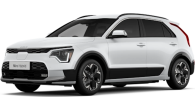The Volvo XC40 - the Chinese-owned Swedish car company's debut in the compact SUV segment - was a hit from the get-go. Stylish, refined, ever-so-cool, and yet not pricey enough to have to go up against the other Euro competition, it kept Volvo's contemporary image intact.
A couple of years later, the XC40 T5 PHEV arrived, before the name was changed to the rather more friendly XC40 Recharge. That's all part of the company's commitment to electrification, which means that by the end of the year, no Volvo will be without some form of electrification, whether it's the subtle mild-hybrid approach or a full-on EV.
The Recharge, then, occupies the middle ground, being a plug-in hybrid, where an electric motor is combined with a petrol engine to deliver a modest but useful electric-only range, but also a (theoretical) total range of almost 1000km between a fill and charge.
Volvo XC40 2021: Recharge Phev (Fwd)
| Engine Type | Turbo 3, 1.5L |
|---|---|
| Fuel Type | Premium Unleaded/Electric |
| Fuel Efficiency | 2.2L/100km (combined) |
| Seating | 5 |
| Price From | $43,340 - $50,380 |
| Safety Rating |
|
Does it represent good value for the price? What features does it come with?
While you can a have an XC40 for just under $47,000 (before on-roads), the Recharge asks $64,990 before options and on-roads.

You get 20-inch alloy wheels, a 14-speaker Harmon Kardon stereo, sat nav, leather seats, power front seats, R-Design bits and pieces (like the steering wheel), dual-zone climate control with air cleaning system, panoramic sunroof, auto LED headlights, auto high beam, wireless phone charging, headlight washers, auto wipers, keyless entry and start and a space-saver spare.

The 9.0-inch, portrait-oriented touchscreen runs a beefy Harmon Kardon 14-speaker stereo and has DAB, Apple CarPlay and Android Auto. It's a slightly confusing system - if you want to change something about the car, it can be a bit laborious getting from the main system back to CarPlay. I'm sure you'd get used to it, but apart from that, the hardware is quick, the menus comprehensible (for the most part) and the side-swiping action quite familiar.
Our test car had metallic paint ($1150), a Versatility Pack (load protection net, power folding headrests - $230), Climate Pack (heated front seats, windscreen washers and steering wheel - $700), around-view camera ($990 - that stings), tinted rear windows ($700), heated rear seats ($350) and auto parking ($650), taking the total to $69,760. Apart from the one that stung, most of these prices are relatively reasonable.
Is there anything interesting about its design?
The XC40 backed up the XC90's design direction, and, like its big brother, it's a belter. The segment has plenty of outstanding designs (that's what happens when everyone gets in on the same game), but the XC40 is a proper looker. From the Hammer of Thor headlights through to the cool concave grille, the upright stance, blacked-out roof and C-pillar, and those signature stacked taillights it's...well, the whole thing is much cooler than it probably should be.

That's not a backhander about Volvo styling - the company has been doing cool for almost 20 years - but the vaguely Minecraft aesthetic shouldn't work, but it does.

The cabin is very nice, too, but in a more conventional way. It's not as bang-up-to-date as a newer German cabin, but then you're not paying another twenty grand for the privilege. The vertical screen works in its environment, the digital dashboard has a high-tech feel and the materials are very pleasant to look at and touch.

How practical is the space inside?
Rear seat passengers enjoy uncommonly comfortable seats with a pretty serious set of headrests, part of the safety package. The optional "electric folding" mechanism means that if you're on your own in the car, you can press a button and they fall forward out of your vision. It's really quite handy, and for a couple of hundred bucks, and it saves a bit of hassle.

There is tons of head and legroom, too, and rear seat passengers score their own air vents.
The boot starts at a handy-if-not-spectacular 460 litres, rising to 1336 litres with the seats folded down. Some of the boot space is nibbled away by the bag holding the charger you use in a standard 240V domestic point, but not hugely so.

There are two pairs of cupholders, one in the front next to the dainty little shifter and two in the rear armrest, which is unusually sturdy. Each door will hold a bottle, too, for a maximum of four.
What are the key stats for the engine and transmission?
As this is a plug-in hybrid, things are a mite more complex than a standard XC40. The internal combustion engine, which both drives the wheels and can charge the batteries, is a 1.5-litre, three-cylinder turbo unit with 132kW and 265Nm, both pretty good figures on their own.

Plugged into that is a 60kW/160Nm electric motor which can drive the car all on its lonesome or in combination with the engine.
Making sure the power gets to the front wheels is a seven-speed twin-clutch automatic and the XC40 Recharge will go from rest to 100km/h in a handy 7.4 seconds - about a second slower than the quickest petrol-only model.
The XC40's charge cable plugs into a charging point on the front left of the car between the wheel and the front door. Using the supplied charger, you'll be waiting around six hours for a from-dead charge. If you can find a fast-charger, it will step down to the XC40's throughput and be done in two and a half hours.
How much fuel does it consume?
Volvo's government-approved ADR testing yielded a slightly silly 2.2L/100km (the Euro-focussed WLTP comes in at 2.0L/100km). This sort of figure is common with PHEVs as the testing cycle is short and not really designed for advanced drivetrains.
Having said that, and throwing out my usual 30 per cent rule (I reckon adding 30 per cent to a fuel figure is probably what you'll get in the real world on a "normal" car), the 5.4L/100km I got during a week's driving is pretty reasonable given the point I was intending to use to charge it didn't work.

The week I spent with it included two separate 30km EV-only runs across the city where the petrol motor kept to itself the whole time, and I still had about six-kilometres of range left. The 10.7kWh battery has a claimed range of 46km so given a good chunk of that running was in 80km/ zones, that's pretty good going.
Warranty & Safety Rating
What safety equipment is fitted? What safety rating?
Being a Volvo, it's laden with safety gear - and you even get a list on the dashboard screen every time you start up, which I think is quite cute.
Along with the usual seven airbags, ABS, and stability and traction controls, the XC40 also has forward AEB (with pedestrian, vehicle, large animal and cyclist detection, and which operates at high and low speed), lane keep assist, blind spot monitoring and reverse cross-traffic alert.
You also get two ISOFIX points and three top-tether anchors. ANCAP last tested the XC40 in July 2018 and awarded it five stars.
What does it cost to own? What warranty is offered?
Volvo throws in a five-year/unlimited-kilometre warranty, which is unusual in the Euro segment. You can also pre-pay your servicing with a plan, covering three-years/45,000km for $1595. Volvo expects to see you once every 12 months or 15,000km.
What's it like to drive around town?
The XC40 Recharge is a delight around town. I'm a big fan of PHEVs (try saying that ten times quickly) because they're a good halfway house between a full BEV, both on price and for dealing with range anxiety (quick reminder, there will likely be a full EV version of the XC40 here by year's end).

It's a well-beaten statistic, but most Australians, all being equal, travel an average of 30-40km per day. Which means that despite me saying 2.2L/100km isn't really accurate, if you're the kind of person who buys this car for the school run or short commute, you'll probably never have to use the petrol engine until you decide to get a bit frisky on the accelerator or, like I did, you take it on a highway run down to the NSW South Coast.
The XC40 Recharge will always use its electric motor, with the software keeping a little bit of charge in hand for stepping off at the lights, which is the biggest contributor to fuel usage. Getting 1700kg-plus of car moving requires a lot of energy.
If you need it, the XC40 can get moving very quickly, and in the urban cut and thrust, the combination of instant electric torque and a very effective turbo three-cylinder means breaking into traffic is a doddle. While the 0-100km/h is quick enough, it's quite lively from 0-60km/h, meaning far fewer of those clench-and-punch-it moments when breaking into moving traffic than some other mid-sized SUVs.
And if you keep it charged - easy enough if you have access to a power point and take the view that each night you charge it the same way you charge your phone - you'll spend the vast amount of your time driving in EV-only mode, which is every relaxing and near silent. Or would be if the 20-inch wheels weren't wrapped in Pirelli P-Zero tyres, but even then they're not too noisy.

It's also very easy to live with, easy to park (especially with the rather expensive 360-degree camera) and the vision out is mostly good, apart from over your left shoulder where the rear quarter window is slashed in twain by a stylish application of the set square. The various safety systems ensure it isn't an issue, however.
Verdict
The Volvo XC40 Recharge packages up the kinds of things I reckon Volvo buyers want - style, safety and advanced technology. The XC40's thrifty fuel use coupled with a useful if not astonishing EV range means you can run this car almost literally on the smell of an oily rag if you're a suburban or urban dweller.
It also offers the flexibility to deliver a drive between our capitals without any of the nail-biting range anxiety so many Australians claim to have, and that is preventing them from buying an EV.
While it's isn't cheap, neither is progress. But at least you're getting a well-equipped, awesome-looking and fun-to-drive SUV with buckets of space and an attractive badge.








.jpg)

.jpg)




































.png)








.png)




.jpg)




